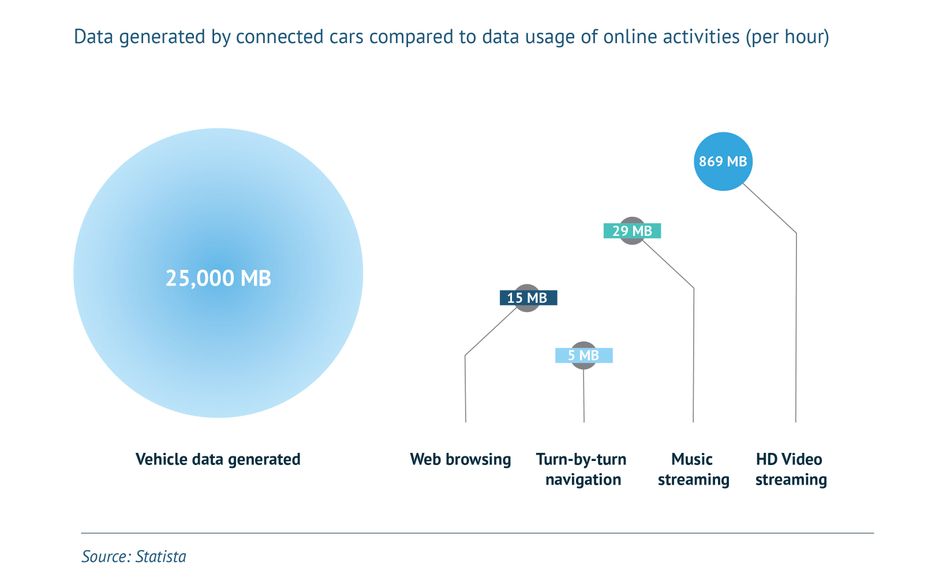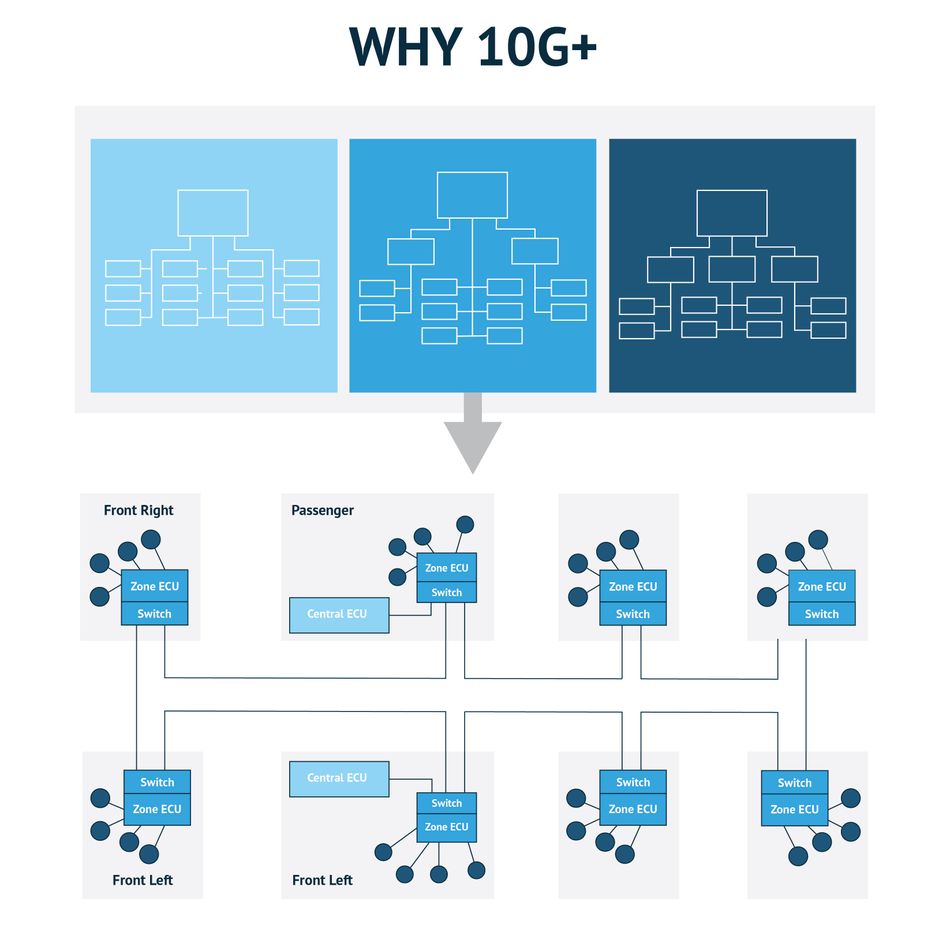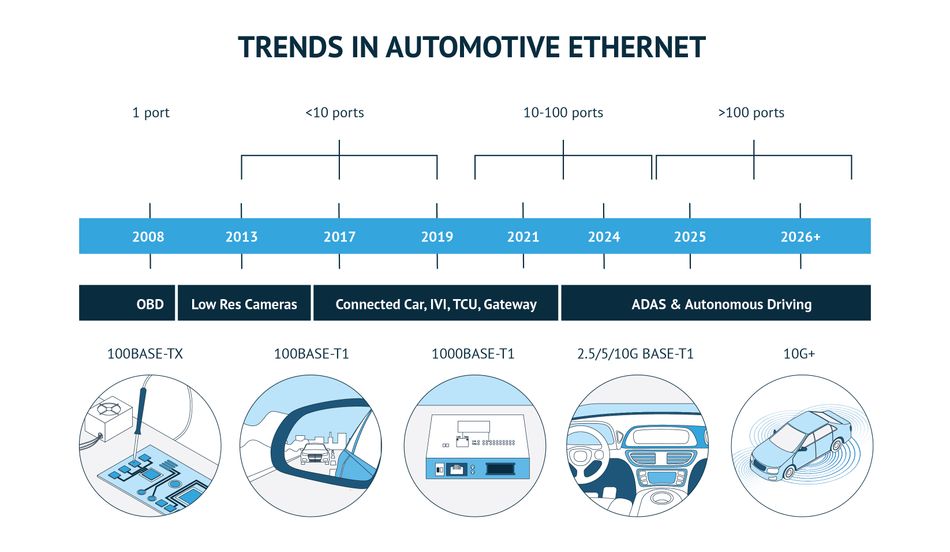High-Speed Data and Connected Cars
Article #2 of our Connected Transport Series. Sensors activate automatic braking to avoid collisions when objects are too close, and they enable headlights to pan as we turn. But high-speed transfer of data is required to keep the connected advances coming.
This is the second article in a 5-part series exploring the connectivity solutions for the future of transportation. The series will detail various connectivity challenges engineers face and describe the technology that will provide the solutions to enhance transportation and driving experience.
This series is sponsored by Mouser Electronics, an online distributor of electronic components. Through their sponsorship, Mouser Electronics supports engineers in building a highly connected transport future in addition to knowledge sharing on related topics of electric vehicles, 5G, and autonomous transport.
We are in the midst of a tremendous transformation of the driving experience as we know it. Vehicles are more connected than ever, and that technology has facilitated changes in virtually every aspect of the vehicle. Sensors alert us when objects are too close, enable automatic braking to avoid collisions, and even allow headlights to pan as we turn. At the same time, global positioning systems (GPS) guide us around traffic to reach our destination more swiftly and safely, while the latest infotainment systems allow streaming of news and other audio content for the driver and movies for passengers.
Connected Mobility Data Demand - A New Post-Covid Trajectory
After years of positive predictions for the number of connected vehicles on the road, the global spread of Covid-19 has caused all sorts of problems throughout the automotive industry and its supply chains. However, stringent CO2 targets will continue to drive EV demand, enhanced by connected features that modernize and enhance the experience of going electric.
What's more, research into post-Covid consumer demands has highlighted the expectation of drivers for seamless, high-speed connectivity and enhanced convenience features when purchasing a new car.
As the number of Connected Cars continues to increase, the extent to which they produce, transmit, and receive data will, too. As autonomous vehicles become more common, the demand for data density and speed will soar. McKinsey & Company predicts that the amount of data transmitted through a connected vehicle (and to and from the cloud) is approximately 25GB of data per hour and will increase to nearly 500GB of data per hour once vehicles are truly autonomous.
 Figure 1: Comparison of the data generated from connected cars compared to online activities. Current Status and Application Areas of 5G
Figure 1: Comparison of the data generated from connected cars compared to online activities. Current Status and Application Areas of 5G

Ubiquitous smartphones and tablets brought the power and speed of 4G LTE technology into vehicles. Now major carriers have begun activating fifth-generation (5G) wireless networks in numerous metropolitan areas. The advent of 5G wireless data has the potential to take intelligent and autonomous driving to the next level by enabling faster data rates and secure vehicle-to-vehicle (V2V) and vehicle-to-infrastructure (V2X) connectivity.
Slated for widespread adoption within a few years, the ability to tap the potential of 5G fully will require continued progress in the development of powerful network infrastructure and in-vehicle processing technologies to assure reliable signal speed with ultra-low latency bandwidth.

As data volume grows exponentially, automotive technologies must maximize speed, signal integrity, and bandwidth - all while minimizing power use, ensuring total safety, and managing thermal heat in space-constrained applications. Electronics have become an integral part of virtually every automotive system, from engine control and transmission monitoring to power seats and advanced climate controls. What once were simple, discrete connections have now evolved into more complex networks, electrifying nearly every automobile system.
The amount of high-speed data is tantamount to a next-generation highway, with information being generated from nearly every part of the vehicle flowing between systems and the gateway via Ethernet. High-speed connected mobility already enables myriad features, including:
- Next-generation infotainment systems capable of streaming audio, video, and more
- Enhanced safety features, including advanced driver assistance systems (ADAS), telematics, radar, cameras, and sensors
- Automated software, diagnostics, and maintenance
- Cloud-based applications and mechanisms to roll out vehicle update over the air
We must differentiate between a connected vehicle and an autonomous one. While they share some of the same technologies, a connected vehicle is one that makes use of the Internet of Things (IoT) and connects the vehicle to other things or other vehicles via the cloud. In contrast, an autonomous vehicle uses data for independent decision-making.
Additionally, because of the extensive development related to autonomous vehicles, demands for enhanced connectivity mean demands for connectors with the ability to reliably deliver high-speed, high-bandwidth, and high-power signals to and from every sensor in a given vehicle.
As a result, top-tier automakers seek solutions for both, asking suppliers to create solutions for the short term that can be implemented with existing infrastructure and develop solutions for tomorrow's demands.

Network Platform Readiness Key to Connected Mobility
In a 2020 KPMG study ranking countries with the highest level of readiness for autonomous driving, the United States ranked third behind The Netherlands and Singapore - and ranked first on the list for technology and innovation with strong industry partnerships. Industry leaders have joined to develop and expand on IEEE 802.3CH standards for high-speed automotive Ethernet applications. The Multi-Gig Automotive Ethernet Task Force (NGAUTO) was established to define specific performance characteristics and operation at 2.5Gbps, 5Gbps, and 10Gbps. Furthermore, IEEE chartered a study group under the 802.3 Ethernet working group for greater than 10Gb/s automotive Ethernet.
Molex platform
Molex has developed multi-gigabit technologies designed to keep data flowing swiftly and securely within vehicles and beyond to the cloud. The next evolution of its 10Gbps Automotive Ethernet Network Platform delivers a vehicle ecosystem with multi-zone integration across hardware, software, and interconnect cabling systems. The platform provides the flexibility to incorporate legacy automotive protocols LIN, CAN, FlexRay, LVDS, and other legacy automotive protocols - and the scalability needed for future upgrades. By integrating features such as superior signal integrity, network traffic prioritization, system scalability, and security, the Molex platform addresses demand for more in-vehicle processing power while helping automakers redefine what's possible in terms of autonomous vehicle technology today - and for the future.
A complementary technology, the Molex HSAutoGig high-speed Ethernet solutions deliver 25Gbps+ data speeds with a reliable interface to seamlessly connect smart-sensor systems and Ethernet network platforms. Sealed, unsealed, and in-line variations support any environment a vehicle would encounter. The high-speed HFM™ FAKRA Mini Coaxial Cable Solution performs up to 20GHz, supporting autonomous and connected vehicle technologies. End-to-end manufacturing capabilities bring new designs to life quickly and at scale. Molex high-density, high-bandwidth designs adhere to stringent standards, including peripheral component interconnect express (PCIe), USB, DisplayPort, mobile industry processor interface (MIPI®), flat-panel display (FPD) Links, and Ethernet.
Other Molex high-speed automotive solutions include the USCAR-30 compliant HSAutoLink I Interconnect System (2Gbps), HSAutoLink Hybrid (Unsealed), and HSAutoLink II (Sealed) Interconnect Systems (13Gbps), all designed to meet increasing bandwidth requirements for advanced in-vehicle infotainment, telematics, and camera devices. Complete with multiple keying options, the full-length cable shielding solutions deliver superior signal performance and speed with reduced electromagnetic interference (EMI), making HSAutoLink ideal for point-to-point in-vehicle connections.
Proven Automotive Engineering Expertise
The groundwork has been laid for continued growth in-vehicle connectivity. Rugged, high-speed, in-vehicle data networks are all vital to achieving the seamless, connected, feature-rich automotive future consumers are demanding, whether in the connected and semi-autonomous vehicles on the road today - or the autonomous vehicles that will become a common sight on the road in the coming years. These high-speed automotive solutions demand a level of expertise and engineering that exceeds many other applications. Much of the design complexity comes from the push to achieve better performance in smaller footprint connectors, cable assemblies, and modules.
Ethernet has ramped up for in-vehicle designs as a proven technology that is flexible, scalable, and built for bandwidth, but only if bottlenecks can be effectively overcome. Consistently and reliably achieving speed-performance goals can only be possible by addressing EMI shielding, attenuation, return loss, mode conversion, crosstalk, impedance, and other issues that can affect signal transmission.
This article was originally published by Mouser and Molex in an e-magazine and substantially edited by the Wevolver team. It's the second article of a 5-part series exploring connectivity solutions for the future of transportation.
The first article examined how the 5G network will deliver Connected Cars.
The third article introduces the modularity challenges of Connected Cars.
The fourth article stressed the importance of regulations and infrastructure changes in order for connected cars to realize their potential.
The fifth article looked at connectivity requirements for ADAS.
About the sponsor
Mouser Electronics is a worldwide leading authorized distributor of semiconductors and electronic components for over 1,100 manufacturer brands. They specialize in the rapid introduction of new products and technologies for design engineers and buyers. Their extensive product offering includes semiconductors, interconnects, passives, and electromechanical components.
References and further reading:
Covid-19 impact on connected vehicle market. www.automotiveworld.com/articles/whats-next-for-the-automotive-industry-in-2021/
Post-Covid car purchasing expectations: www.thedigitallifeindex.publicissapient.com/industry-insights/transportation
McKinsey & Co. Connected Car data:https://www.mckinsey.com/industries/automotive-and-assembly/our-insights/unlocking-the-full-life-cycle-value-from-connected-car-data
KPMG Autonomous Vehicles Readiness Index: https://home.kpmg/xx/en/home/insights/2020/06/autonomous-vehicles-readiness-index.html
The Multigig Multi-Gig Automotive Ethernet taskforce: www.ieee802.org/3/ch/public/


